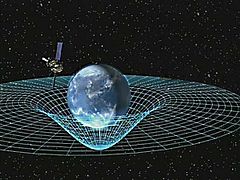User:Maschen/Thermodynamics in curved spacetime
| Part of a series on |
| Spacetime |
|---|
 |
In general relativistic physics, and it's numerous applications to astrophysics, thermodynamics in curved spacetime is the mathematical description of classical thermodynamics in curved spacetime.
Equilibrium thermodynamics[edit]
Thermodynamic laws[edit]
Each of the classical thermodynamic laws can be stated in a number of equivalent ways. The fundamental thermodynamic relation combines the first and second laws into one:
The second law can be also be stated as:
From a more fundamental and modern perspective, a more fundamental law of thermodynamics is baryon number conservation. To formulate this; denote the number density of baryons (number of baryons N per unit 3d volume V) by n in the rest frame, then the proper time derivative of total number is zero:
and the changes in volume are given as the four-divergence of the four velocity u of the fluid:
Explicitly rewriting the divergence term leads to a simpler continuity equation:
where the baryon number flux vector is:
The relativistic generalization of eqn (X) is:
where the equality holds for thermal equilibrium only, the inequality is strict for non-equilibrium.
Non-equilibrium thermodynamics[edit]
Relativistic heat conduction[edit]
See also[edit]
References[edit]
Notes[edit]
- C.W. Misner, K.S. Thorne, J.A. Wheeler. Gravitation. p. 1146. ISBN 0-7167-0344-0.
{{cite book}}: CS1 maint: multiple names: authors list (link)
- R. Yang (2012). "The thermal entropy density of spacetime" (PDF). arXiv:1110.5810v2. doi:10.3390/e15010156.
{{cite news}}: CS1 maint: unflagged free DOI (link)
- H.E. Camblong (2005). [repository.usfca.edu/cgi/viewcontent.cgi?article=1020&context=phys "Semiclassical Methods in Curved Spacetime andBlack Hole Thermodynamics"].
{{cite news}}: Check|url=value (help) [1]
- V. Valeri, P. Frolov, I.D. Novikov (1998). Black hole physics: basic concepts and new developments. Fundamental theories of physics. Vol. 96. Springer. ISBN 0-792-351-452.
{{cite book}}: CS1 maint: multiple names: authors list (link)
For AM in GR:
- T. Padmanabhan (2010). Gravitation: Foundations and Frontiers. Cambridge University Press. ISBN 1-139-485-393.







